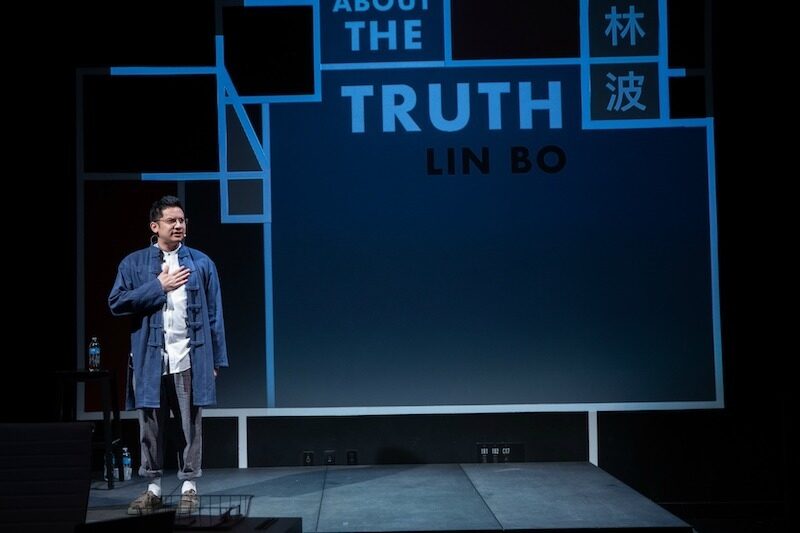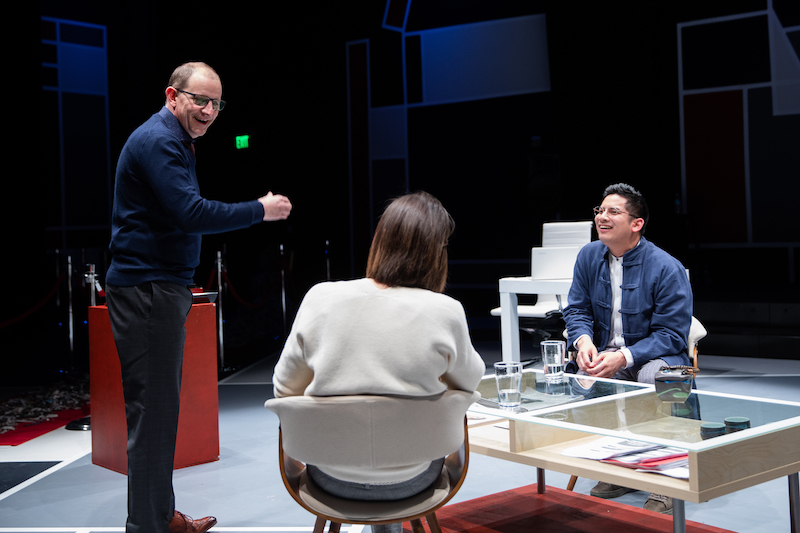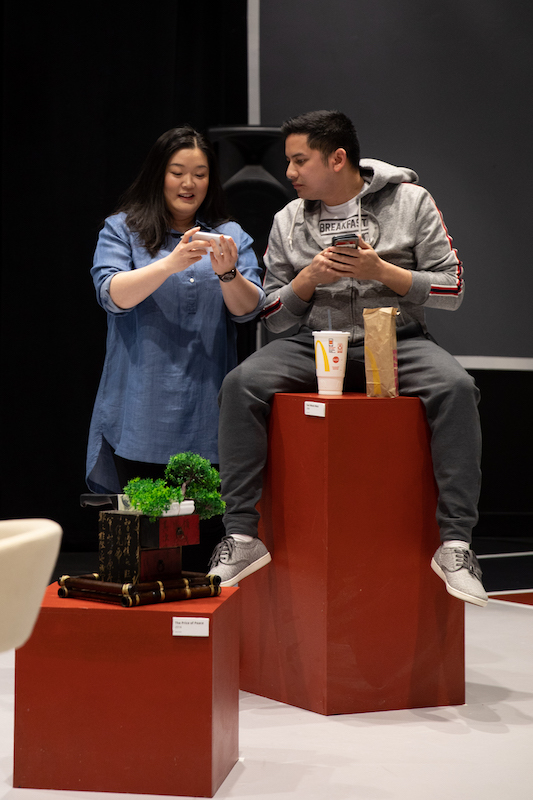CAUGHT Up In Lies
Review of CAUGHT at Intiman Theatre.
Written by TeenTix Newsroom Writer Olivia Sun, and edited by Teen Editor Anya Shukla!

Chinese-American playwright Christopher Chen blurs illusion with reality and time with space in his innovative piece CAUGHT, presented by Intiman Theatre at 12th Avenue Arts. CAUGHT (which ran March 7-March 30) is Chen’s rejection of conventional categorizations of art, a highly inventive artistic work that crosses between theatrical performance, visual arts exhibit, and artist talkback.
Walking into the theatre space, I step onstage to observe a small arts gallery, consisting of everyday objects that hint at the push-and-pull dynamic between Chinese and American culture. The performance begins with a TED talk-esque speech by dissident artist Lin Bo (Justin Huertas), who describes how the post-Tiananmen climate in China had inspired him to set up an imaginary protest against the Chinese government—an act that ultimately leads to his imprisonment. Before we know it, Chen seamlessly switches the setting to that of a journalist’s office, where Lin Bo is questioned again and again about his imprisonment, until the truthfulness of his account unravels. Chen shifts the scope of the performance yet again; now, two performers (Jonelle Jordan and Narea Kang) act out an artist’s interview that explores how truth and lies manifest in our culture. Chen changes the location once more, to a scene “after the show” where two actors discuss their motivations for creating CAUGHT and come to realize that they had been lied to by someone they had thought to be truthful. By the end of the performance, we are left questioning the authenticity of stories told by journalists, historians, and artists alike. What we believe to be the truth is simply based off the stories we hear and share all around us.

In an attempt to dismantle the categorization that dictates our lives, Chen throws us into different contexts from one scene to the other. CAUGHT points out that the boundaries of truth—in journalism, per se—will not be the same as those placed on other categories, such as the arts. What may be “fake news” in media could be described as an ingenious piece of artwork. However, the unchecked truth in the arts can have devastating consequences on our society’s understanding. Art is such an impactful medium that drives our society’s beliefs, and hence, we must use the power of art to accurately portray the facts. With the current leniency given to artists, Chen presents the following questions: Is art completely subjective? To what extent should artists be held responsible for delivering the truth?
CAUGHT also raises concerns about the stories told by the media. In an American capitalist society, journalists, like those covering Lin Bo’s story, are constantly on the lookout for interesting, impactful stories to generate maximum publicity. But when it comes to light that Bo faked being a Chinese artist to get a taste of fame, the career of his interviewer, due to her own indiscretion, is jeopardized. CAUGHT shows that the news is riddled with exaggerations and hyperboles: not only do journalists inflate the significance of events, but they also collaborate with others who have their own ulterior motives to hide the truth. Even if we don’t recognize it, we all contribute to the ocean of lies that surround us to satisfy our personal incentives. Chen suggests that ultimately, humans are self-deluded, insincere beings blinded by a thirst for material success.

CAUGHT’s concept seemed to pull elements from the tragic drama Death of a Salesman, by Arthur Miller, in addition to Shakespeare’s Hamlet, ultimately culminating in an original, mind-boggling theatre performance. Just like how Miller blurred the lines between fantasy and reality through the use of flashbacks, Chen creates a similar effect by throwing the audience into different settings and displaying a fake interview that directly discusses the complex nature of our deluded, real-life society. Even more, Chen also employs the actor-pretending-to-be-an-actor technique as used by Shakespeare in Hamlet, further confusing the audience. In this way, Chen uses the CAUGHT performance itself as a model for the illusionary effects of storytelling—the audience can no longer make distinctions between who is acting and who is not, underlining the increasing interconnectedness of performance and reality.
Is it okay to stretch the truth to craft an interesting narrative? Although this seems to be immoral, it also seems to become the status quo in today’s competition-driven culture. In light of recent college-admissions scandals, dramatizing and embellishing our true personas seems to be virtually inevitable if we want to be noticed by society. As we leave the performance, Chen forces us to question our personal values: which would we choose, economic success or integrity? Because the dark truth is that in today’s cutthroat culture, there seems to be no middle ground.
Lead photo credit: Naomi Ishisaka
The Teen Editorial Staff is made up of 5 teens who curate the review portion of the TeenTix blog and manage the TeenTix Newsroom. More information about the Teen Editorial Staff can be found HERE.
The TeenTix Press Corps promotes critical thinking, communication, and information literacy through criticism and journalism practice for teens. For more information about the Press Corps program see HERE.


